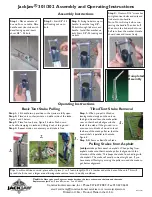
TALEX Spółka z ograniczoną odpowiedzialnością
ul. Dworcowa 9c
77-141 Borzytuchom
tel. (59) 821 13 40
e-mail:
9. Operating principle
9.1 Raking and forming of windrows
The rotor constitutes the main working element of the hay rake and it consists of a
reduction gearbox equipped with 11 arm housings to accommodate tine arms. Via PTO
shaft the torque is transferred from the tractor to main drive shaft located inside the
main frame and then to the rotor gearbox. Transmission of the torque to the gearbox
causes swivel movements of the rotor. Inside the rotor housing there are cam rollers
connected to the individual tine arm housings. During swivel motion of the rotor, the
rollers run on the cam track of special construction forcing their movement up and
down as well as their pivoting motion. This allows for the fluid alteration of the vertical
and horizontal position of the raking tines. In the raking phase the raking arms are
lowered and the vertically set tines come into contact with the crop dragging it sideways
in a sweeping motion. The thrown outwards crop stops on the crop deflector forming a
uniform windrow. In the next phase the arms are lifted, the tines pulled out of the crop
and angled in which position they stay until they reach the raking area again. This
motion creates sufficient clearance not to drag the crop back into the raking area.
Combination of all these features makes the machine thorough and efficient but gentle to
the crop.
Fig. 3. Working principals of the hay rake – The tinted field indicates raking area
where the raking tines are directed perpendicularly to the ground.
















































